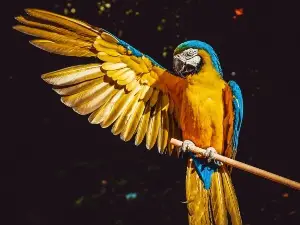
Infections will not only affect humans, they can affect birds as well, and not only this, birds can also develop infections of the feather as well.
This article is a look into black feather fungus
Black feather fungus:
You may be treating your bird very well but fungal infections may still develop on your bird.
If your bird has black deposits on its feathers then the bird may have developed black feather fungus.
The condition is more common in psittacine birds like lories, cockatoos, and macaws but this condition can affect a variety of other birds as well.
This condition is more common in pet birds who are housed inside because of how the birds live and are handled.
The fungus usually develops on birds that routinely have oily deposits on their feathers and these oily deposits usually come from the hands of the people who handle the birds.
The fungus can also develop on the bird’s covert feathers, covert feathers are feathers that cover other feathers, they are the outer feathers of the bird.
Birds use their covert feathers when wiping food off of their beaks. The bird’s food may contain oils.
This condition also more often affects birds who aren’t in the best shape health wise and it also seems to more often affect birds who don’t have good hygiene.
If your bird is left untreated, and buries its head in these soiled feathers, or is simply around these soiled feathers, then the bird runs the risk of developing aspergillosis.
What to do:
Taking your bird to the vet if you think that your bird is suffering from black feather fungus is recommended.
If it is found that your bird does have this infection then the heavily soiled feathers will be gently removed by the vet by plucking.
The vet will put the bird under anesthesia before plucking, this process will be painful to the bird if done without it.
Once this is done, your bird will be misted with a solution that contains chlorhexidine. This chemical is a disinfectant and an antiseptic and will keep more fungi from growing on your bird.
This misting will need to be done once or twice weekly until the bird grows a new set of feathers.
If you enjoyed this article then you may also be interested in other bird related articles. Here are some articles that you may be interested in: Budgie Cere Hypertrophy, Budgie Cere Overgrowth, Why Is My Budgie’s Beak Dry?, How To Tell If Birds Are Bonded To Each Other, How To Know If A Parrot Is Angry, Why Are My Bird’s Feathers Turning Grey?, Cockatiel Growth On Side Of Beak, Black Spots On Cockatiel Feathers, Conure Feathers Turning Black

